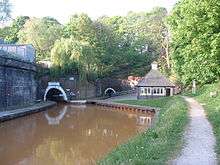Harecastle Tunnel

Northern end of the Harecastle Tunnel. The "Brindley" tunnel is on the right.
|
|
| Overview | |
|---|---|
| Location | Kidsgrove to Tunstall, Staffordshire, England |
| Coordinates | 53°4′27″N 2°14′11″W / 53.07417°N 2.23639°WCoordinates: 53°4′27″N 2°14′11″W / 53.07417°N 2.23639°W |
| OS grid reference | SJ843529 |
| Status | Open |
| Waterway | Trent and Mersey Canal |
| Start | 53°3′46.62″N 2°13′35.64″W / 53.0629500°N 2.2265667°W |
| End | 53°5′4.44″N 2°14′39.24″W / 53.0845667°N 2.2442333°W |
| Operation | |
| Constructed | 1824–1827 |
| Owner | British Waterways |
| Technical | |
| Design engineer | Thomas Telford |
| Length | 2,675 metres (2,926 yards) |
| Towpath | No (removed) |
| Boat-passable | Yes |
Harecastle Tunnel is a canal tunnel on the Trent and Mersey Canal in Staffordshire between Kidsgrove and Tunstall. It comprises two separate and parallel tunnels described as "Brindley" and the later "Telford" after the engineers who constructed them. The tunnel was built to transport coal to heat the kilns in the Staffordshire Potteries. At 1.5 miles (2.4 km) it was once one of the longest canal tunnels in Britain.
Today only the Telford tunnel is navigable. The tunnel is only wide enough to carry traffic in one direction at a time and boats are sent through in groups, alternating northbound and southbound. Ventilation is handled by large fans at the south portal.
The Brindley tunnel was constructed by James Brindley between 1770 and 1777. Brindley died during its construction. At the time of its construction it was one of the two longest canal tunnels in Britain, together with Norwood tunnel, its twin Brindley, bore on the Chesterfield Canal.
To construct the canal, the line of the tunnel was ranged over the hill and then fifteen vertical shafts were sunk into the ground. It was from these that heads were driven on the canal line. A major problem was the change in the rock type which ranged from soft earth to Millstone Grit. The construction site was also subject to flooding regularly, a problem which was overcome by the construction of steam engines to operate the pumps. Stoves were installed at the bottom of upcast pipes to overcome the problem of ventilation.
The tunnel had no towpath, and so boatsmen had to leg their way through the tunnel, lying on the roof of their boat and pushing on the sides of the tunnel with their feet. It could take up to three hours to get through the tunnel. The boat horses were led over Harecastle Hill via 'Boathorse Road'. A lodge (Bourne Cottage) was built by the side of the squire's drive at the point that the boat children crossed it, to prevent them straying up towards Clough Hall.
The tunnel was 12 feet tall at its tallest point and was nine feet wide at its widest, which proved to be too small in later years. The tunnel suffered subsidence in the early 20th century and was closed after a partial collapse in 1914. Inspections of the disused tunnel continued until the 1960s, but since that time, there has been no attempt to investigate the interior of the tunnel at any significant distance from the portals.
...
Wikipedia
